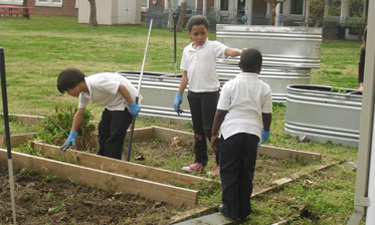 Two years ago, I was attempting to play football in the back of my recreation center in Alexandria, Virginia, with some youth who were determined to prove that a woman who wears heels everyday did not have the capability of throwing a football, when I noticed how much land was available to us. The wide open space was beckoning me to do something with it; it was more than the proving ground to teach equality to young boys about female athleticism. There was the potential for gardening. I had been looking for a way to ensure that our youth spent as much time outdoors as indoors, while also doing something to give back to the community. What activity we could do together and learn from one another while appreciating nature? Gardening!
Two years ago, I was attempting to play football in the back of my recreation center in Alexandria, Virginia, with some youth who were determined to prove that a woman who wears heels everyday did not have the capability of throwing a football, when I noticed how much land was available to us. The wide open space was beckoning me to do something with it; it was more than the proving ground to teach equality to young boys about female athleticism. There was the potential for gardening. I had been looking for a way to ensure that our youth spent as much time outdoors as indoors, while also doing something to give back to the community. What activity we could do together and learn from one another while appreciating nature? Gardening!
Soon after, I measured out what I deemed to be a reasonably manageable garden (seven feet by seven feet). Even though we had enough space, space isn’t a deal breaker, anyway, because container gardens are just as suitable (they don’t require much space) and are definitely en vogue.
I then looked in-house for guidance about the types of vegetables that could thrive with our soil type. Our city horticulturalist extraordinaire, John Walsh, was ready and willing to help with our community gardening project and donated the needed soil (our soil, it turned out, was conducive only for growing strong weeds). He also advised us on what to grow and when to plant it. The Virginia Cooperative Extension provided information about America the Beautiful, an organization that donates hundreds of seeds a year to organizations interested in gardening. It definitely helps to lean on knowledgeable colleagues and other resources when starting a gardening initiative.
Networking with colleagues within the recreation and parks department and the general community allowed me to start a community garden without using funds from my center’s budget: dirt (donated), seeds (donated), sun (free), and water (not free, but that can be handled, too). Make your water company aware of your community garden and it will take you through the process of reducing the charges for sewage. Again, this is knowledge I gained by connecting with Virginia Cooperative Extension. Making these connections enlarged the scope of the project because it became clear that much more was being planted than just plants to feed our bodies.
Relationships were sprouting among people whose paths would not have crossed had it not been for the community garden. The narrative about the garden started to include comparisons from nature to describe the richness of human diversity. Gardening was a way to teach a number of lessons about the importance of diversity within everyday life. Our youth interacted with other cultures and learned how engaging in a joint activity can bring about more than ingredients for a recipe to be consumed.
Consumed, they did. The children's faces are unforgettable images, as they smiled while fingering the soil, digging the hole that they deemed just right to place seeds. They chattered nervously debating on how far apart vegetables should be and of course who would label the vegetables and water. I sat back and watched how diligent they were with the garden; asking everyday if something had grown. They went out to investigate, overwater, and sometimes over-nurture; but always with the best of intentions.
Gardening lends itself to so many growth metaphors. Planting seeds of hope into young people and then working with them each day as a means of nurturing those seeds served as the initial goals of the gardening project.
McKenya Dilworth-Abdalla is the center director at the Charles Barrett Recreation Center in Alexandria, Virginia.

